For a class I taught, called Intoxicating Poetry, we read the Bacchae and the Cyclops. They were told at the start of the semester that they would be doing a creative translation project, and I gave them some examples to give them an idea of what translation can be. The examples were entirely chosen based on my own taste, but they were meant to give students an idea of the range of things that can be “translation” (some might prefer to use “reception” or “adaptation” for some of these works — my goal was in part to complicate or collapse that distinction a bit). You can click on any of these pictures for (with apologies to Winnie the Pooh) a little longer short sample.
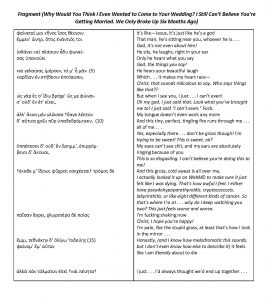
I also shared a translation of my own, of Sappho 31. I mention this because I think it helped my students feel comfortable trying to produce something creative on their own. I read my poem to them, and I told them what I was trying to achieve and whether or not I thought it was successful. I’ve always told students that I’ve dabbled in creative translation when I’ve assigned something like this, but this was the first time I’ve actually given them something I’ve written. As you can imagine, it’s a little scary to do something like that, which is precisely why I did it. I’m asking my students to take a chance and do something artistic — an academic paper has always felt more impersonal to me, whereas an artistic or creative production feels much more personal. There’s more of myself in it, and it feels riskier to show that that someone else. The emotional stakes of failure feel higher (as though a negative review is a negative opinion of my heart as opposed to my brain). If I feel that way, I should at least be prepared for the possibility that my students feel that way, which is why I think it’s important to offer a certain amount of vulnerability if you’re asking that of your students.
Here’s the assignment I used. A few things to note, if you’re thinking about doing something similar (which I hope you will!).
The vast majority of the points on this assignment were for the accompanying reflection paper. This wasn’t a creative writing course — I’m not at all qualified to teach or evaluate a creative writing course. I made it very clear to my students what the purpose of the assignment was and how they would be evaluated (via rubrics), since I knew this was very likely something they hadn’t been asked to do before.
They were asked to write a reflection paper that used one of two readings — Benjamin’s “On The Task of the Translator and/or “Schleiermacher’s On the Different Methods of Translating” — to approach their project. They were told “This reflection (c. 500 words) should include some thoughts about your chosen translation theory text (Benjamin or Schleiermacher), though these thoughts can agree or disagree with that text. All I’m asking is that you engage in some sense with a theory of translation and think about what translation can/should entail, beyond just the most precise grammatical representation of the source text.” This was the crux of how I officially assessed their work. This made my life much easier (I never feel like I can really evaluate creative production in a way that will be fair and somewhat objective) and I hope it made them feel more comfortable approaching this project, knowing how they would be evaluated and that the objective quality of their art wasn’t going to “count” heavily in a grade sense.
Per the rubric, an excellent translation would involve:
- Noticeable departure from the source text with some clear vision for the
project; takes significant creative chances (Creativity, ambition, and vision made up 25% of the translation grade) - Translation has a significant and thoughtful relationship to the source text – artistic choices reflect the text you chose in some way (Use of source text made up 25% as well)
- Diction is well suited to your overall goals. Register and tone advances your vision (Language choice made up 20%)
- Final product reflects your goals and vision for the project, as detailed in the reflection paper (Execution made up 5%)
Again, not the belabor the point, but execution is such a small part of their grade. 5% of 30% of the final grade for this project.
Their reflection essays were broken out as follows:
- Choices made and overall vision (35%)
- Challenges and Take-Aways (35%)
- Engagement with Secondary Readings (25%)
- Grammar, Spelling, and Style (5%)
So, how did they do? OMG, Y’ALL — THEIR PROJECT WERE SO GOOD!
Student Projects
They all gave me permission to share these (I’m not a monster!). They blew me away on all fronts here — both the quality of the art they produced and the depth of their reflections. Enjoy these awesome works. I’m so proud of these students!
Student 1
Project: a GORGEOUS rendering of the Chorus at Bacchae 977-1023. I love everything about their work so much.
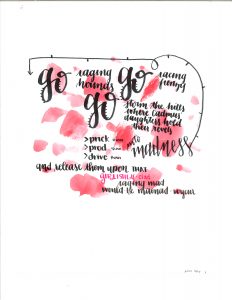

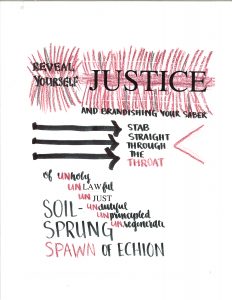
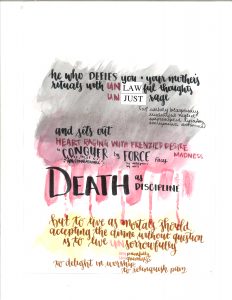
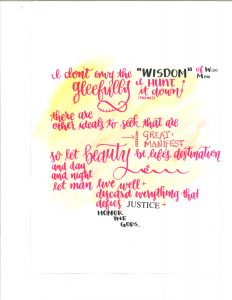
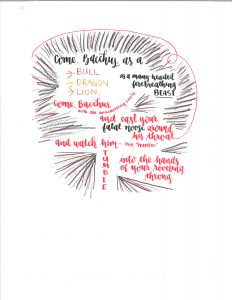
Some awesome bits from their reflection:
- “When I first read this passage, I was struck by its visuality; like in the messenger speeches, the choral ode uses words to present a very vivid image of violence, and we’re led to picture Pentheus’ death, even though it doesn’t appear onstage and in fact hasn’t even happened yet. I was also fascinated by the apparent tonal shift of the passage, from goading on violence to promoting beauty and the kind of serenity achieved by honoring the gods, and the way different parts of the ode seem to conflict with each other. From the start, I wanted to express these impressions (the visuality, the tonal shifts and contradictions) through color, font, and visual organization. As I went on and thought more about the translation articles, I started focusing more on the details of vocabulary, word placement, and sound that contributed to those impressions. The sound effects of refrain in lines 991-996 and 1013-1016 were especially important for me; I thought a lot about how the repeating sounds (φ, ον, γ, the alpha prefix) conveyed the chorus’ aggression and almost created the impression of stabbing, and I tried to express this through the sounds and visual arrangement of the words I used as well. I aimed to do this with the rest of the passage as well, but I think this portion of my translation was the most successful.”
- “After reading Benjamin, I also found myself wondering how translation should handle the performative aspect of Greek tragedy, the fact that its language would have been supplemented by music, vocal intonation, and choreography. Is the translator obligated to reproduce how the Greek, in its sounds and connotations, seems to lend itself to more abstract expression of its intention, whether through art, as I attempted, or through music or dance? Or is that entirely out of the reach of a non-musical expert, dealing strictly with the text? Or does this perhaps fall into the realm of interpretation, rather than translation? The distinction of interpretation and translation too, though, remained a little foggy for me; I struggled sometimes to determine whether my impression was derived strictly from the text, what it said and how it said it—Benjamin’s ‘pure language’— from my personal thoughts and impressions, or even perhaps from what I wanted the text to be doing.”
Student 2
Project: Bacchae 1259-84 that explores madness in the original as a question of mental health (the translation is here)
Some awesome bits from their reflection:
- “In my translation, I wanted to play around with the idea of Dionysiac madness and equate it to a mental illness that could be healed with a pill. Real mental illnesses obviously do not respond as quickly to medicine as portrayed in this scene, and are very complicated issues. However, I thought this would provide an interesting foil to the idea of madness induced by Dionysius. So, to that end, I did not even mention Dionysius, but focused instead on the idea that Agave has been trapped inside her own head because of a mental illness.”
- “As for my own translation, I think that I changed the intent of the passage in some ways. Rather than look at the revenge of the god Dionysius upon his family members as punishment for their refusal to acknowledge him as a god, I chose instead to examine the relationship between Cadmus and Agave and the question of whether there is a responsibility or a difficulty in bringing someone back from a mentally constructed world in which they are happy, into a reality which will make them miserable. So, my own translation theory utilized here, differing from Benjamin’s, allows one to take the essential elements of a text and switch around the focus. By engaging with the text from a different perspective and presenting it in a different way, I think that new ways of engaging with the original text are also opened up and presented to the reader.”
Student 3
Project: Bacchae 1251-84 that gives us access to Agave’s internal monologue as she’s in the process of coming back to her senses (the translation is here)
Some awesome bits from their reflection:
- “The recognition scene captivated me because we see Agave transition from maenad, to sober Theban woman, to a woman severed from one fundamental aspect of her identity. She has committed the crime most antithetical to her role as mother; she has reversed the role of creator and nurturer and become the destroyer. The amount of pain, grief, confusion, and self-hatred, that must have been running through her at the same time was something that I wanted to explore further by giving her inner thoughts between lines I tried to get across this transformation through word choice.”
- “While reading Benjamin’s ‘On the Task of the Translator’ one idea that was hard for me to accept, but I eventually did, was that translation should not try to emulate the meaning of the original. I think that his point is valid, because two different languages will always have their own nuances and will never completely align. Later he notes ‘A real translation is transparent; it does not cover the original, does not block its light, but allows the pure language, as though reinforced by its own medium, to shine upon the original all the more fully’ (260). I think this quote encapsulates what good translations are capable of doing, which is allowing both the original and the translation to convey meaning. I tried to do this in my creative translation through the addition of the inner monologue of Agave. One place where I disagreed with Benjamin was his claim that the translator should not worry about what the original meaning is. As a classicist, I think it is important to do both; to study what the original meant through close reading, and then when creating a polished translation to express the relationship of the languages to one another (255). Translating this passage in class allowed me to gain an understanding of what the original was doing, so then I could take the next step and convey meaning in English. Translation theory challenged me to move beyond my tendency to stick to the original as much as possible.”
Student 4
Project: A diorama of Pentheus getting ripped to pieces in the hills, complete with trees (appropriately) made from champagne bottles!

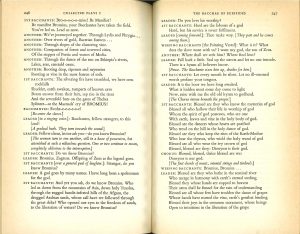
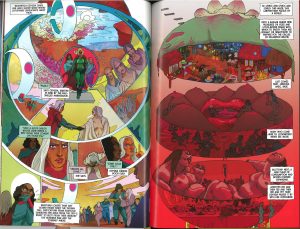
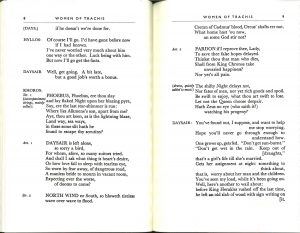
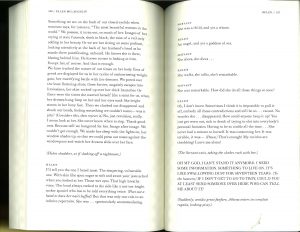
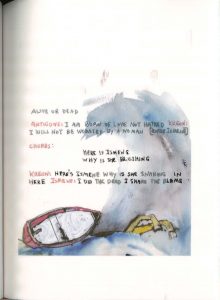

no replies